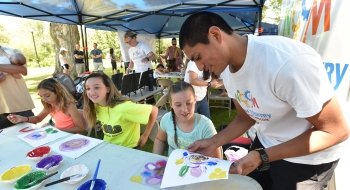
Our Liberal Arts Approach to Artificial Intelligence
Ask ChatGPT for a one-sentence answer to the question: “Should St. Lawrence University, whose mission is to provide an inspiring and demanding undergraduate education in the liberal arts, approach AI with excitement or with skepticism?”
At this point, chances are excellent that if you haven’t already created your own ChatGPT account, you’ve at least heard of the artificial intelligence large language model that has become the topic of much debate since it was released in November 2022.
The tool that can understand and generate text that mimics human conversation is capable of engaging in discussion, answering most any question, writing research papers, and performing a variety of other text-based tasks, including producing sophisticated computer code—all within a few seconds. It also creates images from text prompts.
Like so much of ChatGPT’s responses, this one is impressively—and maybe a bit disconcertingly—smart: “St. Lawrence University should approach AI with a balanced mix of excitement and critical skepticism to fully leverage its potential while addressing its ethical and societal implications.”
Critical Digital Scholarship
Director of Digital Initiatives Eric Williams-Bergen ’91 is a major part of the University’s efforts to do just that. “The spring semester of 2023 marked the start of numerous conversations around AI,” he says, recalling a watershed moment during an annual learning conference for faculty the week after Commencement. “Several colleagues and I gave a presentation about AI. Everyone was trying to figure out what AI means for our daily lives, work, and research.” The conference had to move to a larger space to accommodate the high turnout.
From their centralized location in Owen D. Young Library, with its two fully equipped podcasting studios and a newly redesigned digital scholarship lab outfitted with a bank of top-of-class Mac computers, Williams-Bergen and Digital Scholarship Specialist Nicole Roche routinely work with a diverse group of students and faculty in every discipline. They have long offered support and expertise in integrating technologies for video creation, data visualization, and podcasting into coursework. Now, as part of that work, they’re introducing relevant AI platforms that enable a wide range of creative endeavors that were previously time-consuming or difficult to achieve.
They’ve also been conducting a lot of individual consultations with faculty to help them design ways to use AI in their research and to figure out how it might impact their teaching.
“I recently ran a session with a philosophy class on American pragmatism and John Dewey. Instead of a traditional essay, the professor was having them do podcasts,” Williams-Bergen says. “As part of what we're teaching them about podcasting, we're also showing them a tool called Descript that does automatic transcription and then word-based audio editing. It’s an AI-generated tool that really has revolutionized what a student or professor can do in terms of audio editing.”
While creating opportunities to explore the promising aspects of AI, he and Roche are also intentional about inviting examination of its pitfalls. Potential problems associated with AI include but aren’t limited to: perpetuating biases present in training data, leading to discriminatory outcomes; privacy concerns that arise when AI systems use vast amounts of personal data, increasing the risk of data breaches and misuse; deepfakes that manipulate or fabricate audio, video, or images, making it appear as though someone is saying or doing something they never actually did and undermining public trust; digital rights violations when AI generates content based on existing works without proper attribution or compensation to original creators; and an over-reliance on AI tools by students, detracting from the development of their critical thinking, writing, and problem-solving skills.
“We're looking at artificial intelligence from all these angles. We think of this approach as critical AI, and it’s important to have our faculty and students experience the AI tools so they can bring a critical lens to the conversation about it,” says Williams-Bergen, whose meticulously organized office is a few steps away from the digital scholarship lab, a newly refurbished space that invites students to engage with AI technologies together, rather than work in isolation. Supported by a $150,000 grant from the Gladys Brooks Foundation and additional grants from Northern New York Libraries, the lab supports not only the new Digital Media & Film major but the University’s broader effort to create digital equity by providing powerful, top-of-the-line computers and professional subscriptions to various AI platforms so all students have access. The lab's setup also encourages students to work in teams and learn from each other, which enhances their understanding and application of AI tools in their academic work.
“It’s a really hands-on, personalized, liberal arts approach to exploring this technology within a collaborative community,” notes Williams-Bergen, who also oversees Digital Scholarship Fellowship program, part of the Sophomore Success Initiative, which engages about 20 students per year with emerging technologies like AI through weekly seminars and hands-on workshops. The Fellows, who receive a small stipend, share their expertise with other students and faculty by providing assistance with assignments and projects.
In the last year, Williams-Bergen has experimented with at least 40 different AI tools. Besides the audio editing tool Descript, some of his favorites include Perplexity, a large-language model he says does a bit better job than ChatGPT for authenticity because it actually includes research citations; Adobe Firefly, a free text-to-image creation tool whose reference library is fully licensed so there’s no risk of copyright violations; CapCut and Davinci Resolve for editing already-shot video; and Suno, which creates music, including vocals, based on text prompts. He also stays current on advances within tools. For example, in May, ChatGPT released a free upgraded version, GPT-4o. This new iteration of the tool allows multi-modal prompting using photo and speech, not just typing text into the search bar. And it scans the web in real time, allowing access to immediate information. “Every week it seems we’re learning a new capability one more of these tools couldn’t do the week before,” he says.
A philosophy major with a master’s in library and information science, Williams-Bergen has been working at St. Lawrence since he transitioned from a career in photojournalism to a focus on digital and data-driven education. He lives on an organic, off-the-grid homestead with goats and chickens—a decidedly low-tech lifestyle that balances his high-tech academic and professional endeavors.
"One of the most appealing ideas I've heard is to think of this less as artificial intelligence and more as intelligence augmentation,” he says. “For example, I use AI constantly for computer coding projects. What used to take me four hours of writing PHP and JavaScript can now be done by ChatGPT in a few minutes. This shows the incredible efficiency and capability of AI, provided you have the foundational understanding. For students, it’s important for them first to get that fundamental kind of intelligence about the topic so that they can become the driver of the platform rather than just taking what it gives and knowing that they don't have the ability to either guide or interpret.”
In other words, AI is most useful to those who have developed the critical thinking skills necessary to design exacting prompts and to understand its limitations.
AI Lingo to Know

With the rise of artificial intelligence, a whole new set of terms has emerged to describe its concepts, capabilities, and ethical considerations. Here are a half-dozen of them, as defined by GPT-4o itself.
Boldly Learning AI Together

St. Lawrence faculty are leading the way in integrating AI into the classroom, turning challenges into opportunities for critical thinking and innovation. From using AI to generate crisis simulations to teaching students how to collaborate with technology, they're redefining what it means to learn in the digital age.
Read How Faculty are Navigating AI in the Classroom
How Chat GPT Saved Our Disney Trip

When planning a Disney trip felt overwhelming, Professor Ronnie Olesker turned to AI for help—and it delivered the magic! Using ChatGPT, she crafted the perfect itinerary, navigating the parks like a pro and making the most of every moment with her family. From avoiding long lines to scheduling the best breaks, AI made what seemed daunting into a dream vacation.
Read How AI Turned a Disney Trip into a Dream Vacation
A Computer Scientists Perspective on AI

Under the guidance of Charles A. Dana Professor of Computer Science Ed Harcourt, students are pushing the boundaries of innovation. From enhancing cybersecurity to creating accessible physical therapy apps, and even classifying sounds with cutting-edge AI, these projects showcase the incredible potential of technology. Yet, Harcourt reminds us that mastering the basics is key—AI is a tool, not a replacement for deep understanding.
Read About Student AI Projects & Classroom Perspectives
Our Real-Life Student Who Inspired an AI Cover Image

Meet Joshua-Daniel Alleyne ’27, an international student from Jamaica majoring in computer science and studio art with a minor in education, and our inspiration for our Summer 2024 AI cover image. For this edition, we envisioned a half-human/half-cyborg portrait of Alleyne, symbolizing intelligence augmentation. But as we explored AI-generated images, we realized the true power of these tools lies in their ability to create entirely new visuals.




